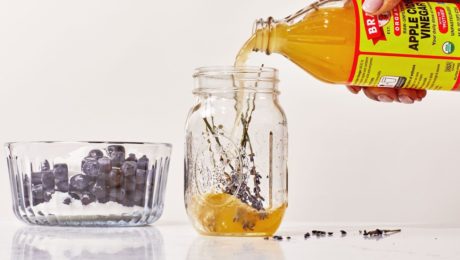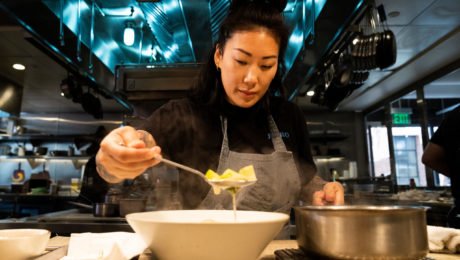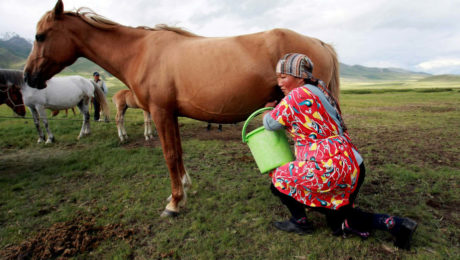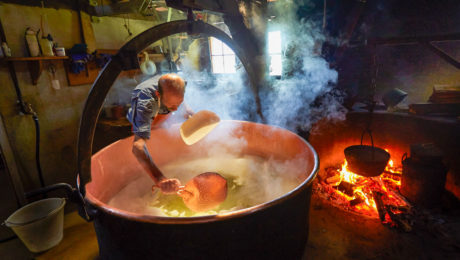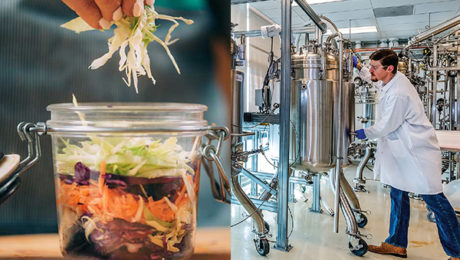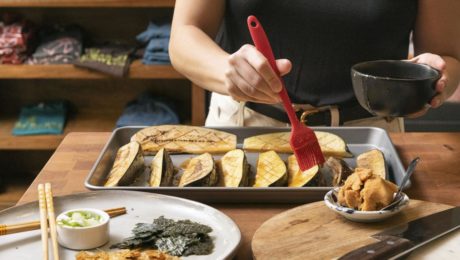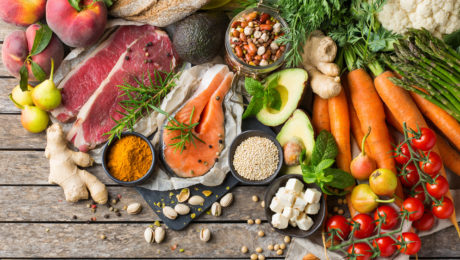Endangered Fermented Foods
Through selective breeding and domestication of plants and livestock, the world’s food system has lost diversity to an alarming degree. Crops are monocultures and animals are single species. Journalist and author Dan Saladino argues it’s vital to the health of humanity and our planet to save these traditional foods.
“There’s an incredible amount of homogenization taking place in the last century, which has resulted in a huge amount of concentration of power in the food system but also a decline in the amount of biodiversity,” says Saladino, author of Eating to Extinction. “That agricultural and biological diversity is disappearing and it’s taken us thousands, millions of years for plant, animal evolution to get to this point.”
Saladino was a keynote speaker at The Fermentation Association’s conference FERMENTATION 2022, his first in-person talk in the United States since his book was released in February. A journalist with the BBC, Saladino was also an active participant in the event, attending multiple days’ worth of educational sessions. He called the conference “mind expanding.”
“I thought I knew about fermentation, when in fact I know very little,” Saladino said to the crowd in his keynote. “We’ve been bemused by the media reports that fermentation is a fad or fashion. What we know is that the modern food system in the last 150 years is the fad. It’s barely a blip in the context of our evolution as species, and it’s the way we’ve survived as a species over thousands of years.”
Eating to Extinction includes 40 stories of endangered foods and beverages, just touching on a fraction of what is happening around the world. To date, over 5,000 endangered items from 130 different countries have been cataloged by the Slow Food Foundation’s project the Ark of Taste.
During FERMENTATION 2022, Saladino centered his remarks around the endangered fermented foods he chronicled in his book – Salers cheese, skerpikjøt, oca, O-Higu soybeans, lambic beer, pu’erh tea, qvevri wine, perry and wild forest coffee. Here are some of the highlights of his presentation.
Salers cheese (Augergne, Central France)
Fermentation was a survival strategy for many early humans, a fact especially evident in the origins of cheesemaking. In areas like Salers in central France, villagers live in inhospitable mountain areas where it’s difficult to access food. In the spring each year, cheesemakers travel up the mountains with their cattle and live like nomads for months.
“It’s extremely laborious, hard work,” Saladino says, noting there’s only a handful of Salers cheese producers left in France. He marvels at “the ingenuity of taking animals up and out to pasture in places where the energy from the sun and from the soil is creating pastures with grasses with wildflowers and herbs and so on.”
Unlike with modern cheese, no starter cultures are used to make Salers cheese. The microbial activity is provided by the environment – the pasture, the animals and even the leftover lactic acid bacteria in the milk barrels. Because of diversity, the taste is rarely consistent, ranging season to season from mild to aggressive.
“The idea of cheesemaking is a way humans expand and explore these new territories assisted by the crucial characters in this: the microbes,” he adds. “It can be argued that cheese is one of most beautiful ways to capture the landscape of food – the microbial activity in grasses, the interaction of breeds of animals that are adapted to the landscape. It’s creating something unique to that place.”
Skerpikjøt (Faroe Islands)
Skerpikjøt “is a powerful illustration to our relationship with animals, with meat eating,” Saladino says. It is fermented mutton and unique to Denmark’s Faroe Islands. Today’s farmers selectively breed their sheep for ideal wool production, then slaughter the lambs for meat. In the Faroes, “the idea of eating lamb was a relatively new concept.” Sheep are considered vital to the farm as long as they’re still producing wool and milk.
Once a sheep dies or is killed, the mutton carcass is air-dried and fermented in a shed for 9-18 months. The resulting product is “said to be anything between Parmesan and death. It certainly has got a challenging, funky fragrance,” Saldino says.
But it contrasts traditional and modern food practices. Skerpikjøt is meant to be consumed in small quantities, delicate slivers of animal proteins used as a garnish. Contemporary meat is served in large portions and meant to be consumed quickly.
Oca (Andes, Bolivia),
In the Andes – “one of the highest, coldest and toughest places on Earth to live” – humans have relied on wild plants like oca, a tuber. After oca is harvested, it’s taken to the Pelechuco River. Holes are dug on the riverbank, then filled with water, hay and muna (Andean mint). Sacks of oca are placed in the holes, weighted down by stones, and left to ferment for a month. This process is vital as it leaches out acid.
“Through processing, this becomes an amazing food,” Saladino says.
But cities are demanding certain types of potatoes, encouraging remote villagers to plant monocultures of potatoes which are prone to diseases. The farmers end up in debt, buying fertilizers and pesticides to grow potatoes.
“For thousands of years, oca and this fermentation technique and the process to make these hockey pucks of carbohydrates and energy kept them alive in that area,” Saladino says. “It’s a diversity that is fast disappearing from the Andes.”
O-Higu soybeans (Okinawa, Japan)
The modern food industry is threatening the O-Higu soybean, too. It was an ideal soybean species – fast-growing, so it can be harvested before the rainy season and the arrival of insects.
“But by the 20th century, the soy culture pretty much disappeared,” Saladino says.
With World War II came one of America’s biggest military bases to Japan. U.S. leaders dictated what food could be planted on the island. Okinawa was self-sufficient in local soy until American soy was introduced.
Lambic Beer (Belgium)
Saldino explained that, after a spring/summer harvest, Belgian farmers became brewers. They used their leftover wheat to create brews unique to the region.
But by the 1950s and 1960s, larger brewers began buying up the smaller ones. Anheuser-Busch InBev now produces one in four beers drunk around the world.
“There [is] story after story of these distinctive, unique, small breweries disappearing as they are bought up or absorbed into this growing, expanding empire of brewing,” Saladino says. “It’s probably one of the most striking cases of corporate consolidation of a drink and food product.”
Saladino stressed not all is lost. He shared stories of scientists, researchers and local people trying to save endangered foods, collecting seeds, restoring crops and combining traditional and modern-day practices to preserve the world’s rare foods.
“There have been so many fascinating stories of science and research discussed over the last few days at this conference, and I think the existence of The Fermentation Association is exciting because it is bringing together tradition, culture, science, culinary skills, all of these things we know food is,” Saladino added. “Food is economics, politics, geography, anthropology, nutrition. What I’m arguing is that these clues or glimpses into the past for these endangered foods, they’re not just some kind of a food museum or an online catalog. They are the solutions that can help us resolve some of the biggest food challenges we have.”
- Published in Food & Flavor
Why did Americans Turn to Drinking ACV?
A deep dive on Epicurious explores how apple cider vinegar (ACV) became America’s favorite. It is popular today as a detox tonic, but has a deep history in the U.S., “intertwined with the global spread of apples and with the transformations of fermentation.”
Today, vinegar is considered an industrialized condiment but, until the 19th Century, it was homemade. Kirsten Shockey, author of Homebrewed Vinegar (and a TFA Advisory Board member) notes the key to making vinegar is nurturing the natural fermentation process. “Vinegar happens whether you want it to or not,” she says. “As soon as fruit is picked, it’s a race against time,” she adds. As the fruit ripens, wild yeasts ferment their sugars into alcohol. Microbes feast on that alcohol, converting it to acetic acid.
Paul C. Bragg, namesake of the Bragg vinegar brand, helped popularize commercial vinegar. Theirs is still a raw, unpasteurized ACV. Paul preached the benefits of vinegar as far back as in the 1970s. This support coincided with “the rise of a countercultural natural food movement, which embraced the brown, gritty and ‘all-natural’ in its refusal of the refined, bleached and heavily processed products of the industrial food system.” (Pop star Katy Perry invested in Bragg in 2019).
The article also highlights artisanal vinegar brands, like American Vinegar Works in Massachusetts and two Pennsylvania producers, Supreme and Keepwell.
Isaiah Billington cofounder of Keepwell says that making vinegar “helps us interact closely with the total landscape of local agriculture.” Vinegar also uses produce that can’t be sold because it’s too ripe, or because the apple is “very ugly.” “We work at the margins of the harvest.”
Read more (Epicurious)
- Published in Food & Flavor
Kimjang, the Act of Preparing Kimchi
As Koreans enter the autumnal kimjang season – the time of year when kimchi is prepared with fresh, seasonal vegetables – The New York Times highlights how cooks outside of Korea are preparing the dish.
“For many communities in South Korea, a kimjang (also spelled gimjang) remains a grand act. But these days, Korean cooks outside of the motherland are adapting to their individual environments accordingly, scaling down their kimjangs to fit their lives or even hosting them virtually,” writes NYT food journalist Eric Kim, author of the book Korean American: Food That Tastes Like Home. “In a world where most people buy their kimchi at the store, preserving the act of preservation has become a priority for Koreans who wish to carry on the tradition of kimjang.”
Many American Koreans have memories of making kimchi with their parents and grandparents. Two women interviewed in the article have made kimchi-making their livelihood. Lauryn Chun, founder of Mother-in-Law’s Kimchi, says “If you can make a salad, you can make kimchi.” Ji Hye Kim, chef of Miss Kim in Michigan, describes kimchi as being like a zombie – “Not quite alive, but not quite dead.”
Kimjang has been recognized as a cultural heritage and “set of living knowledge” by UNESCO since 2013. The pickled flavor and gamchil mat (meaning “savory taste” in Korean) are defining elements of kimchi.
Read more (The New York Times)
- Published in Food & Flavor
Chicago: A Fermentation Hub
If you still think of hot dogs and deep dish pizza as the icons of Chicago’s culinary scene, you need to think again. The so-called Capital of the Midwest is a hub of innovation in the food industry. Chicago has the largest food and beverage production in the U.S., with an annual output of $9.4 billion. Food startup companies in the region raised $723 million in venture capital last year.
“Chicago is one of the most diverse cities for eating,” says Anna Desai, Chicago-based influencer of Would You Like Something to Eat on Instagram. ”Our culinary scene is constantly elevating and evolving. We are always just a neighborhood or tollway away from experiencing a new culture and cuisine. I’m most excited when I find an under-the-radar spot or discover a maker who can pair flavors and ingredients that get you curious and wanting more.”
Desai started her blog in part because she wanted to champion the Asian American and Pacific Islanders (AAPI) community in the Chicago food and beverage scene. “Food has long served as a cultural crossroad,” she adds, and Chicago’s multicultural cuisine exemplifies that sentiment.
Chicago is home to some of the most creative minds in fermentation, from celebrity chefs, zero waste ventures, alternative protein corporations and the world’s largest commercial kefir producer. There are dozens of regional and artisanal producers lacto-fermenting vegetables, brewing kombucha and experimenting with microbes in food and drink.
“Chicago is a great food city in its own right, so naturally there is a ton of talent in the fermentation space,” says Sam Smithson, chef and culinary director of CultureBox, a Chicago-based fermentation subscription box. “The pandemic’s effect on restaurants has also spawned a new wave of fermenters (ourselves included) that are looking for a path outside the grueling and uncertain restaurant structure to display our creative efforts. This new wave is undoubtedly community-motivated and concerned more with mutual aid than competition. There is a general feeling that we are all working towards the same goal so cooperation and collaboration is soaring and we are seeing incredible food come from that.”
Flavor is King
Flavor development is still the prime motivation for chefs to experiment with fermentation. A good example is at Heritage Restaurant and Caviar Bar in Chicago’s Humboldt Park neighborhood.
“Fermentation has been a cornerstone of the restaurant since its inception,” says Tiffany Meikle, co-owner of Heritage with her husband, Guy. “With the diverse cuisines we pull from, both from Eastern and Central Europe and East Asia, we researched fermentation methodologies and histories, and started to ‘connect the dots’ of each culture’s fermentation and pickling backgrounds.”
Menus have included sourdough dark Russian rye bread, toasted caraway sauerkraut, kimchi made from apples, Korean pears and beets and a kimchi using pickled ramps (wild onions). Heritage has also expanded their fermentation program to the bar, where they’ve created homemade kombucha, roasted pineapple tepache, sweet pickled fruits for cocktail garnishes, and kimchi-infused bloody mary mix.
“It’s fascinating to me that there are so many ingredients you can use in a fermented product,” says Claire Ridge, co-founder of Luna Bay Booch, a Chicago-based alcoholic kombucha producer. “People are really experimenting with interesting ingredients in kombucha…I have seen brewers do some of the wildest recipes and some recipes that are very basic.”
Innovating Food
Chicago-based Lifeway Kefir is indicative of the innovation taking place in the city. Last year the company expanded into a new space: oat-based fermentation, launching a dairy-free, cultured oat milk with live and active probiotics.
“We’ve spent so many years laying the groundwork in fermented dairy,” says Julie Smolyansky, CEO. “Now we’re experimenting and expanding to see what’s over the next horizon, though we’ll always have kefir as our first love.”
Chicago is home for two inventive fermented alternative protein startups: Nature’s Fynd and Hyfé Foods. Both companies were born out of the desire to create alt foods without damaging the environmental.
“Conscious consumerism is a trend that’s driving many people to try alternative proteins, and it’s not hard to understand why,” says Debbie Yaver, chief scientific officer at Nature’s Fynd. The company uses fermentation technology to grow Fy, a nutritional fungi protein. “Fungi as a source of protein offer a shortcut through the food chain because they don’t require the acres of land or water needed to support plant growth or animal grazing, making fungi-based protein more efficient to produce than other options.”
Alternative foods outlasting the typical trend cycle is a challenge for companies like Nature’s Fynd. When grown at scale, Fy uses 99% less land, 99% less water and emits 94% fewer greenhouse gasses than raising beef. But, to make an impact, “we need more than just vegans and vegetarians to make changes in their diets,” Yaver adds.
Waste Not
Numerous companies are using fermentation as a means to eliminate waste. Hyfé Foods, another player in the alternative protein space, repurposes sugar water from food production to create a low-carb, protein-rich flour. Fermentation turns a waste product into mycelium flour, mycelium being the root network – or hyphae (hence the company name) — of mushrooms.
“[We’re] diverting input to the landfill and reducing greenhouse gas emissions at scale,” says Michelle Ruiz, founder. “Hyfé operates at the intersection of climate and health, enabling regional production of low cost, alternative protein that reduces carbon emissions and is decoupled from agriculture.”
Symmetry Wood is another Chicago upcycler. They convert SCOBY from kombucha into a material, Pyrus, that resembles exotic wood. Founder Gabe Tavas says Pyrus has been used to produce guitar picks, jewelry and veneers. Symmetry uses the discarded SCOBY from local kombucha brand Kombuchade.
Many area restaurants and culinary brands also use fermentation to preserve food for the long Chicago winters, when local produce isn’t available. Pop-up restaurant Andare, for example, incorporates fermentation into classic Italian dishes.
“Finding ways to utilize what would otherwise be waste products inspired our initial dive into fermentation. The goal is not just to use what’s leftover, but to make it into something delicious and unique,” says Mo Scariano, Andare’s CEO. “One of our first dishes employing koji fermentation was a summer squash stuffed cappellacci served with a butter sauce made from carrot juice fermented with arborio rice koji. Living in a place with a short grow season, preservation through fermentation allowed us access throughout the year to ingredients we only have fresh for a few weeks during the summer.”
Industry Challenges
Despite growing interest and increasing sales, fermenters face some significant hurdles.
Smithson at CultureBox says he sees that consumers are open to unorthodox, less traditional ferments. Though favorites like kombucha and sauerkraut dominate the market, “their share is being encroached on by increasingly more varied and niche ferments.” But getting these products to market can be a challenge. Small-scale, culinary producers are challenged by the regulatory hoops they need to jump through to legally sell ferments – especially unusual ones a food inspector doesn’t recognize.
“The added layer of city regulations on top of state requirements, sluggish health department responses, and inflexible policy chill the potential of small producers,” Smithson says. But he highlights the recently-passed Home-to-Market Act of Illinois as positive legislation helping startup fermenters.
Consumer awareness and education are also vital. “Many longstanding and harmful misconceptions on the safety and value of fermented products still exist,” Smithson says.
Matt Lancor, founder and CEO of Kombuchade makes consumer education a core part of marketing, to align kombucha as a recovery drink.
“Most mainstream kombuchas are marketed towards the yoga/crystal/candle crowd, and I saw a major opportunity to create and market a product for the mainstream athletic community,” he says. “We’re on a mission to educate athletes and the general public about these newly discovered organs [the gut] – our second brain – and fuel the next generation of American athletes with thirst quenching, probiotic rich beverages.”
Product packaging provides much of a consumer’s education. Jack Joseph, founder and CEO of Komunity Kombucha, says simplicity is key.
“People are more conscious of their health now, more than ever before,” he says. “So now it comes down to the education of the product and creating something that is transparent and easy for the consumer to digest.”
Sebastian Vargo of Chicago-based Vargo Brother Ferments agrees.
“Oftentimes food is considered ‘safe’ due to lack of microbes and how sterile it is,” he says. “Fermentation eschews the traditional sense of what makes food ‘safe’. We need to create a set standardized guide for fermented food to follow, and change our view of living foods in general. One of the brightest spots to me is the fact that fermentation is really hitting its stride and finding its place in the modern world, and I don’t see it going anywhere but up in the near future.”
- Published in Business, Food & Flavor
“Koreanique” Food
As more Korean adoptees come of age to run restaurants, a new dining style is emerging: “Koreanique” (or Korean-style, Korean-inspired or “kinda Korean”).
“For these chefs, cooking is the ultimate reclamation of their Koreanness — and an act that pushes the cuisine to exciting places,” reads an article in The New York Times.
They produce dishes that “reflect their American upbringings and Korean heritage” of the adoptee chefs. Examples are: Jewish matzo ball soup with Korean mirepoix, Spam musubi burritos, kimchi-enriched carbonara, chicken marinated in kimchi brine, battered fish-sauce-laden zucchini with a sweet soy dipping sauce, jajangmyeon sauce with Bolognese and gochujang barbecue sauce.
Still, they note, feelings of imposter syndrome and cultural appropriation can take over. Adoptee chefs tell The Times they worry they’re not making Korean food authentically and they struggle with their complicated relationships with Korean food when they grew up eating a different culture’s food.
Read more (The New York Times)
- Published in Food & Flavor
Would You Drink Fermented Horse Milk?
The country of Kyrgyzstan is hoping to attract tourists by highlighting traditional kumis – fermented mare’s milk. Locals drink and bathe in the liquid for health benefits. Promotional films romanticize a visit to the Asian country, highlighting how one can experience the nomadic Kyrgyz lifestyle by sleeping in a mountain yurt near herds of horses.
“We decided to try it after hearing about saamal (another word for mare’s milk) and kumis from our friends who had visited Kyrgyzstan,” says Ibrahim al-Sharif, a tourist from Mecca, Saudi Arabia, in a CNN Travel article. “I cannot even describe its taste. There is nothing in Saudi Arabia that I would compare with it.”
CNN notes “milking a mare is far trickier than milking a cow.” A person must be big enough to reach their arms around the horse’s thigh. A milking is not done year round but in mid-May and mid-July, traditionally ending when the Pleiades star cluster appears.
Read more (CNN)
- Published in Food & Flavor
Domesticating Fermented Food Microbes
Humans have domesticated plants and animals since the early days of civilization, changing the life cycles, appearances and behaviors of crops and livestock. A new study shows humans have done the same to fermented products, selectively taming microbes. But as a result, microbial strains have evolved to where they can no longer survive in the wild.
“The burst of flavor from summer’s first sweet corn and the proud stance of a show dog both testify to the power of domestication,” reads an article in Science titled “Humans tamed the microbes behind cheese, soy, and more.” “But so does the microbial alchemy that turns milk into cheese, grain into bread, and soy into miso. Like the ancestors of the corn and the dog, the fungi and bacteria that drive these transformations were modified for human use. And their genomes have acquired many of the classic signatures of domestication.”
Humans have used selective breeding to produce the most desired traits in plants and animals – for example, making a plant less bitter or an animal larger. Thousands of years of domestication have changed DNA. Though microbes can’t be bred the same way, “humans can grow microbes and select variants that best serve our purposes.” It’s now left “genetic hallmarks similar to those in domesticated plants and animals: The microbes have lost genes, evolved into new species or strains and become unable to thrive in the wild.”
Scientists shared this research during two talks at Microbe 2022, the annual meeting of the American Society for Microbiology in Washington D.C. The talks – “Origins and Consequences of Microbial Strain Diversity” and “Microbial Diversity in Food Systems: From Farm to Fork”
– were convened by TFA Advisory Board members Benjamin Wolfe, PhD, ofTufts University, and Josephine Wee, PhD, from Penn State. They invited various academics to present their research on these topics.
Microbial Domestication in Cheese
Wolfe said the studies “are getting to the mechanisms” of how microbial domestication works. They reveal “which genes are key to microbes’ prized traits – and which can be lost,” continues the Science article. This work is critical to the future of food, as these microbe gene traits can shape fermented foods and beverages.
Presenters included Vincent Somerville, PhD, from the University of Lausanne, Switzerland, speaking on the changing genomic structure of cheese cultures. He pointed out that bread yeasts have long been domesticated. They’ve lost so much of their genetic variation that they can’t live in the wild. Other microbes are “lacking clear evidence of domestication … in part because [their] microbial communities can be hard to study,” he said.
Somerville’s research revolves around a starter culture for a Swiss hard cheese. Bacterial cheese starters were created by early cheesemakers; in the 70s, samples of these cultures began being banked to ensure quality. But Somerville and his collaborators, after sequencing the genomes of more than 100 of these samples, found little genetic diversity, with just a few strains of two dominant species..
“The exciting thing from this work was having samples over time,” Wolfe said. “You can see the shaping of diversity,” with changes in the past 50 years hinting at the trajectory of change over past centuries.
Domesticated vs. Wild Aspergillus
John Gibbons, a genomicist at the University of Massachusetts, Amherst, presented on Aspergillus oryzae, “the fungus that jump-starts production of sake from rice, and soy sauce and miso from soybeans.” Farmers cultivate A. oryzae, which reproduces on its own. “But when humans take a little finished sake and transfer it to a rice mash to begin fermentation anew, they also transfer cells of the fungal strains that evolved and survived best during the first round of fermentation,” the article reads.
Gibbons compared the genomes of A. oryzae strains with those of A. flavus, it’s wild ancestor. Human involvement in transferring the fungus has “boosted A. oryzae’s ability to break down starches and to tolerate the alcohol produced by fermentation.” The domesticated Aspergillus strains may have up to five times the number of genes used to break down starches compared to their ancestors.
“The restructuring of metabolism appears to be a hallmark of domestication in fungi,” he said.
Gibbons also found the genes of domesticated A. oryzae to have little variation. And some key genes have disappeared, “including those for toxins that would kill the yeast needed to complete fermentation — and which can make humans sick.” The article concludes: “Domestication has apparently made A. oryzae more human friendly, just as it bred bitter flavors out of many food plants.”
- Published in Science
Will Fermentation Connect Gastronomy and Biotech?
Fermentation is motivating scientists to listen to gastronomers, a rare occurrence in the field of science.
“There’s going to be a huge exchange in this two-way road that we’re living in. Innovation in flavor coming from gastronomy and innovation coming from a high-level biotechnology, they are going to be harmonious,” says Jason White, director of the fermentation lab at Noma in Copenhagen. “We’re going to be able to create this infrastructure and community of people who have the same goal, and the same goal is going to be the wellness of our planet.”
White spoke at the 2nd international Food Innovation Conference. This annual gathering of industry experts is produced by the Gottlieb Duttweiler Institute (GDI), Switzerland’s oldest independent think tank, which researches the future of food, retail and health.
The conference focused on the future of fermented alternative proteins. Or, as GDI puts it: “how innovation can solve the carnivore conundrum.” Speakers included the founders of numerous precision fermentation companies, such as SuperBrewed Food, Bosque Foods, Melt&Marble and WNWN Food Labs.
“We do the same thing, we just have different outputs”
Fermentation for alternative proteins is a divisive topic among traditional fermenters. Many say it’s lab-created fake food. Advocates, though, argue precision fermentation using DNA from mammals (as with Impossible Foods’ heme protein burger) and biomass fermentation of fast-growing, naturally-occurring organisms(e.g., Nature’s Fynd fungi protein) are reducing the risk of a global food crisis. Meat consumption is increasing, but animal meat is environmentally inefficient to raise. The significant amounts of agricultural land, fertilizer, pesticide and hormones needed to raise animals for meat protein release harmful carbon emissions.
The chefs on GDI’s “Fermentation: A World Within Gastronomy” panel spoke favorably of using fermentation for alt foods. White was joined by Ezio Bertorelli, co-founder of fermentation shop Meta Copenhagen, and Sirkka Hammer, founder of food manufacturer Wiener Miso in Austria.
“I think that it’s important for us not to steer too far away from the origins of fermentation,” White notes. But, “whether you have this bioreactor filled with whatever working inside of a laboratory with a team of scientists, we are still creating something that comes from microorganisms and from organisms. And so we do the same thing, we just have different outputs, different audiences.”
Precision fermentation technology is rooted in traditional fermentation, he notes. You need to understand the abilities of microbes and composition of ingredients for a successful precision fermentation.
“Inside of these laboratories and restaurants, there’s so many things that are being discovered that stop at the guest experience,” White says of fermentation. Today, as fermentation continues a revitalization as a kitchen craft, it’s utilized by more people rather than just chefs and scientists.
DIscovering Fermentation
Hammer highlighted the boom in home fermentation, with people creating the bold flavors of fermented foods and beverages on their own countertops.
“There’s a certain magic in fermentation. That’s why you’re gripped with it,” she says. “People are bringing a little bit of that magic, uncontrollable magic maybe [into their homes].”
At Wiener Miso, Hammer launched the company’s umami-driven ferments after living in Asia for more than a decade. The spices, pastes and sauces she makes are based on traditional Japanese ferments.
“Fermenting gives you in gastronomy next level or an add-on of flavors and textures,” she says. “Fermentation really changes the texture in a different way than if you cook it or freeze it. It gives it new dimensions.”
Flavor is what introduced Bertorelli to fermentation, too. His background is in professional cooking – he is the former executive chef of La Petite Table in Paris – but he was always experimenting with miso and sauerkraut in his home kitchen.
Even today, his fermentation experiments “go terribly wrong most of the time,” says Bertorelli. Only about 5% are successes, “that’s what makes it exciting.”
“Fermentation really changed my life because it showed me most of the dishes I was passionate about, the origin of the flavor, was the fermented part,” he says. “Flavor is universal… If you have that mind-blowing moment, it can reconnect you with things that are inside all of us, like our ancestors have been eating these foods since thousands of years ago and it’s sort of like going back in time while still being here.”
- Published in Food & Flavor
The Unsung History of Umami
In the early 1900s, Japanese chemist Dr. Kikunae Ikeda discovered the flavor umami by distilling it from soup stock. That compound – which is an amino acid, glutamate — produces the savory flavor in meat, mushrooms and seaweed. Ikeda called the flavor after the Japanese word umami which means “essence of deliciousness.”
“It is the peculiar taste which we feel as umai, meaning brothy, meaty or savory, arising from fish, meat and so forth,” Ikeda wrote in the Journal of Tokyo Chemical Society.
A huge discovery, umami became the fifth flavor next to salty, sweet, sour and bitter. Ikeda went on to start a company, Ajinomoto, which mass produces monosodium glutamate — MSG — a key ingredient in producing umami.
But it took nearly 100 years for umami to be recognized by the broader scientific community, especially in the western world. An NPR story points to the anti-Asian “Chinese Restaurant Syndrome” which began in the 60s and 70s. MSG was vilified as an unhealthy additive, numbing mouths and making people sick (an apparent fable modern food scientists have never been able to prove). Another reason: umami research may have been ignored in the U.S. because of tension with Japan during World War II .
“Fermented foods and seasonings like sake, soy sauce, miso were a large part of the diet in Japan and also a large part of the economy. And so research into the flavor components of those kinds of foods were an important part of rationalizing diet in Japan.”
says Victoria Lee, professor and author of “The Arts Of The Microbial World.”
Read more (NPR)
- Published in Food & Flavor
Dietitians Say: Nordic Diet Healthiest Option
The Nordic Diet is getting more attention from dietitians, who are encouraging clients to embrace a range of fruits, vegetables, fish and fermented food and drink.
“’The Nordic diet features a large variety of foods, without any strict restrictions, which are key to a sustainable way of eating,” says Tamara Willner, London-based nutritionist.
Though the Mediterranean diet has dominated dietitians’ wellness advice, the Nordic diet is a heartier option. It includes seasonal foods that thrive in colder climates, like root vegetables – beets, carrots, turnips – and fruits – plums, apples and berries. Fish like herring are also recommended. Fermented food is a key differentiator between the two diets – kefir, fermented fish and fermented vegetables are prominent in Nordic countries.
“Our gut hosts a huge number of gut microbes that feed off the foods we eat and produce more bacteria,” Willner continues.
The Nordic diet is cheaper to maintain, too. The produce is generally less expensive and the Nordic diet relies on whole grains, beans or lentils.
Read more (Daily Mail)
- Published in Food & Flavor


